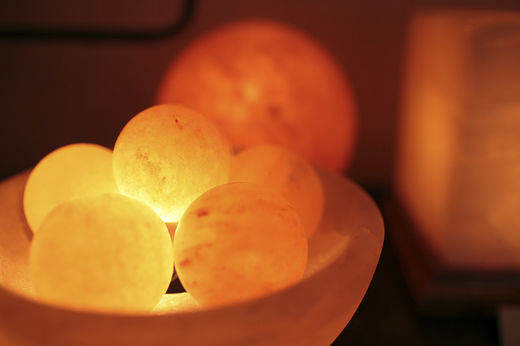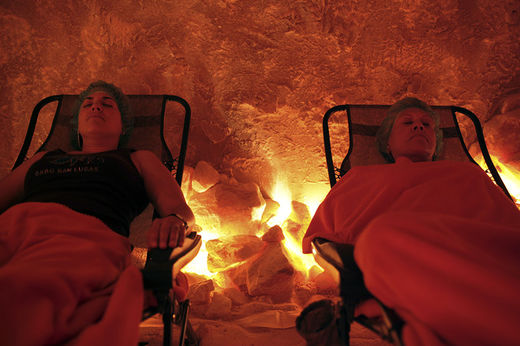
Across the U.S., salt rooms have been popping up in cities such as New York, Orlando, Naples, Fla., Boulder, Colo., Chicago and Los Angeles.
While most of us associate salt air with the beach, from a medical standpoint, the experience is designed to mimic salt caves, which have long been considered therapeutic in Eastern Europe. Salt room owners say salt can help skin conditions such as psoriasis and eczema and a range of respiratory ailments, including colds, asthma, allergies and bronchitis.
Sometimes called halotherapy chambers, the rooms are designed to provide a relaxing and unusual experience. The walls and ceilings are salt-coated, and grains are often scattered a few inches deep on the floor. Children are often allowed to play in it, as in a sandbox. Some places have cave-like decor, complete with salt-coated stalactites.
Some facilities just pile up salt in the room, while others use special "salt generators," machines that grind the salt into very tiny breathable particles and blow it into the air. Orlando's Salt Room uses a generator sold by Indium Top LLC of Tallinn, Estonia. Halo Air LLC of New York, which recently opened a Halo/Air salt room in Manhattan, uses a generator from Halomed UAB, of Vilnius, Lithuania. Halo Air hopes to open dozens more locations in the U.S.
Generally, pure salt from natural sources is used; Halo Air uses rock salt from a cave in Ukraine. The smell of a salt room is a little like ocean air and visitors experience a salty taste on the lips, says Richard Zagrobelny, owner of Iris Salt Rooms LLC, a Kitchener, Ontario, firm that builds salt rooms using Indium Top's Iiris machine. Costs for a session vary, depending on location and privacy; some rooms offer discounts for multiple sessions. A one-hour adult session in a communal room at the Salt Room in Orlando costs $45. Halo Air says a private room with a personal television costs $100 for an hour. If you like you can wear nothing but a thin robe and booties on your feet.
So far the Iiris machine hasn't been studied clinically. The Halomed device has been shown effective for respiratory and skin conditions in Russian-language research publications, says Russian pulmonologist Alina Chervinskaya, a minority owner of Halomed. The machine is set to different levels of salt concentration depending on the condition being treated, she says. Halo Air says concentrations in its salt rooms range from five to 10 milligrams per cubic meter of air for adults.
Salt helps respiratory conditions by drawing water into airways, thinning mucus and improving the function of cilia, or small hairs that help move mucus out of the lungs, Dr. Chervinskaya says. In higher concentrations, salt therapy also can help skin conditions such as acne and psoriasis, she says.
And a 160-person study Dr. Chervinskaya presented last year at a Vienna medical conference found that a tabletop salt generator, not available in the U.S., helped prevent colds. Dr. Chervinskaya says the tabletop unit produces a dry salt aerosol comparable to the Halomed generator used in salt rooms.
English-language studies on salt rooms are rare. Often quoted by salt rooms as evidence of their efficacy is a landmark New England Journal of Medicine study that found improvement in cystic-fibrosis symptoms from salt therapy. But the study used a handheld nebulizer twice daily to deliver a concentrated salt mist into the mouth, and the results don't apply to salt rooms, says Australian scientist Mark R. Elkins, the lead author of the 2006 paper.
Orlando pulmonologist Daniel Layish says rigorous studies are lacking on salt rooms, but he has found cystic-fibrosis patients he has referred to the Orlando Salt Room are experiencing "less shortness of breath, less coughing and decreased sinus pressure."
Springfield, N.J., allergist Leonard Bielory, chairman of the American College of Allergy, Asthma & Immunology's integrative-medicine committee, says it's logical that salt rooms could help a variety of respiratory conditions—but probably only in the short term. "It's like a massage," he says. "Great while you get it but after that [the benefit is] gone."
Dr. Bielory and others caution that asthma could potentially be worsened. Salt is an irritant that could cause airways to constrict, posing a serious danger to asthmatics, says allergist Alvin M. Sanico, an assistant professor at Johns Hopkins University School of Medicine in Baltimore. Salt, by stimulating nerves in the nasal passages, may worsen allergy symptoms, he adds.
Dr. Chervinskaya says that 10 to 20 sessions in salt rooms using the Halomed machine can have long-term benefits of up to six months or a year. Generators should be set to a lower dose for asthma patients to minimize irritation, she adds, and patients with any serious lung issues should consult their doctors before using a salt room. Halo Air says it follows Dr. Chervinskaya's recommendations. Salt rooms in rare cases can cause mild irritation to the skin and eyes, and a scratchiness in the throat that goes away after drinking water.




Reader Comments
to our Newsletter